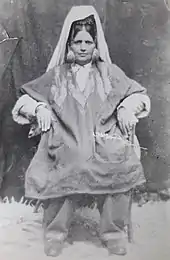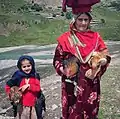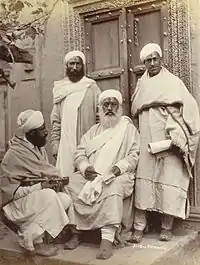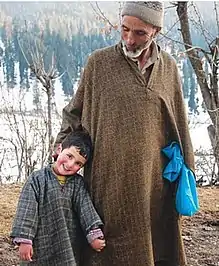 A young man wearing Pheran somewhere in Chenab Valley's Doda district | |
| Type | Traditional Dress |
|---|---|
| Material | Wool and Cotton |
| Place of origin | Kashmir |
Pheran ⓘ[lower-alpha 1] or Phiran is the traditional outfit for both males and females in Kashmir.[1]
The pheran consists of two gowns, one over the other.[2] The traditional pheran extends to the feet, which was popular up to the late 19th century C.E.[3] However, a relatively modern variation of the pheran extends to below the knees,[4] which is worn with a suthan inside (loose form of shalwar) similar to the styles worn in Afghanistan.[5][6]
It is optional to wear the suthan with a long phiran as traditionally lower garments are not worn with pherans. The traditional pheran do not have side slits.
According to some sources, the pheran was introduced by Mughal emperor Akbar when he conquered the valley in 1586.[7]
In summer, the pheran are made of cotton, but in winter, the pheran is made of wool, covering and protecting the body from the cold especially during snow. These dresses are used by the residents of the Kashmir valley and Kashmiris residing in Chenab Valley.
Since Pheran is unique to the kashmiri culture and it is worn particularly to protect oneself from the coolest phase(Chilai Kalan-starts from December 21) in winter, December 21 is now being celebrated as Pheran Day in Kashmir valley.
Etymology
According to one theory, pheran is a corruption of the Persian word 'perahan' which means cloak.[8] The outfit has been in vogue in Kashmir since before the 15th century.[9]
Designs
Head dress

Taranga
Hindu women use a headwear called "taranga" (Kashmiri pronunciation: [tarɨngɨ]), which is a headdress which becomes smaller down at back, towards the heels. It is popular in some areas of Kashmir.
Kasaba
Kashmiri Muslim women use a headwear known as the "kasaba" (Kashmiri pronunciation: [kasaːbɨ]). The kasaba is padded by means of a turban and is pinned together by brooches. A veil made of pashmina or Silk is pinned to the top of the kasaba that descends towards the back of the neck. There are two types of kasaba: "Thoud kasaba" and "Bonn kasaba". Thoud kasaba (high kasaba) sits on the head like a crown, worn only by married women belonging to elite families. House of khwajawal in Naid kadal made the most beautiful kasabas.[10] Bonn kasaba (low kasaba) sits on head like a bandana, worn by commoners and tribal women.[10] The most magnificent and expensive kasabas were made of kashmiri kundan work known as "Jarrah": precious gem stones, usually rubies, spinels and emerald are set in 24 carat gold to make various kundan ornaments (Tikka, Taweez, Hung taweez, Bal hor, kan vass) pinned to the red cap having intricate Kashmiri "Tilla work" (silver thread work). Kundan kasaba was worn only by royals.[11] Kundan kasaba were only made by house of Kundanghar in Khwaja bazar.[11]

Pheran
The pheran is a loose upper garment loosely gathered at the sleeves, which tend to be wide,[12] made of either wool or jamewar, which is a mixture of wool and cotton,[5] with no side slits. A pheran made of wool is called a 'loch'.[13] Female pheran dresses are designed with colorful flowerlike designed elements and styles. Male pheran dresses are quite simple, without any colourful design.
The traditional pheran falls to the feet like a gown.[14] This style was universally worn by the Kashmiri Hindu and Kashmiri Muslim communities into the later 19th century C.E.[15] However, a modern version worn by Muslims is knee-length, loose and stitched on the front side ane finishes, while Hindus often still wear their pherans long, extending down the legs. Ankle length Pherans[16] are tied at the waist.[17] Intricate embroideries or flower styles are a popular on Kashmiri ladies pherans. The embroideries or flower designs are made of thin metal threads; this kind of embroidery is known as 'Tille' in Kashmiri language.
Poots
The poots (Kashmiri pronunciation: [poːt͡sʰ]) is the same as the pheran but made of lighter material; it is worn beneath the pheran. It is generally used to protect the pheran from burns from the kangri. It also provides extra warmth during winters, double layer insulation from the cold winter days.
Suthan/shalwar
Traditionally, the pheran and poots were worn without a lower garment.[18][19] Indeed, in neighbouring Hunza too, women did not wear pajamas until 1890 and in Nagar until 1925.[20] Since the latter part of the 19th century, loose suthans (shalwars) and churidar pajamas of the Punjab region became popular in Kashmir.[21][22] Accordingly, the suthan or churidar pajama can form part of the pheran ensemble but is not a must. The Kashmiri suthan is baggy and loose and is similar to the Dogri suthan worn in the Jammu region. Some versions are similar to the shalwars worn in Afghanistan. However, since the 1960s, the straight cut Punjabi salwar has become popular.[23][24][25]
Modern fashion
Modern trends saw a decline in the use of pherans in favour of the shalwar kameez.[26] However, there has been a revival in recent years as pherans have become part of modern fashion,[27] and are worn by females of other areas of Kashmir as well.[28] Kashmiri men are also wearing the pheran as a fashionable outfit.[29] Combined with jeans, the pheran has made its way into the office world.[30] The modern pheran is not as wide and long[31] as the traditional ankle or knee-length version and sometimes has side slits. Fewer men are wearing the phiran with a shalwar.[32] Modern pherans, known as Raglan Pherans are a hybrid of western raglan coat and traditional wear.[33]
Photo gallery
 Kashmiri Muslim children wearing Pheran
Kashmiri Muslim children wearing Pheran Kashmiri Muslim girls in traditional pheran
Kashmiri Muslim girls in traditional pheran Kashmiri Muslim woman with her granddaughter
Kashmiri Muslim woman with her granddaughter A young man wearing Pheran somewhere in Chenab Valley's Doda district
A young man wearing Pheran somewhere in Chenab Valley's Doda district Kashmiri Muslim women in traditional long pheran, 1870
Kashmiri Muslim women in traditional long pheran, 1870 Men in Kashmiri pheran and poots, 1875
Men in Kashmiri pheran and poots, 1875 1919 drawing of Kashmiri Pandit women wearing intricately decorated pherans
1919 drawing of Kashmiri Pandit women wearing intricately decorated pherans Kashmiri Pandit men in Kashmir, 1895
Kashmiri Pandit men in Kashmir, 1895 A young man wearing a fitted, fur-collared, fashionable Pheran in Chenab Valley's Bhaderwah
A young man wearing a fitted, fur-collared, fashionable Pheran in Chenab Valley's Bhaderwah Elderly Kashmiri man with his grandson in traditional pheran
Elderly Kashmiri man with his grandson in traditional pheran
See also
Notes
- ↑ Pronounced in Kashmiri pronunciation: [pʰʲaran]
References
- ↑ Bakshi, S. R. (1997). Kashmir Through Ages (5 Vol) By S. R. Bakshi. ISBN 9788185431710.
- ↑ Tikoo, Colonel Tej K. Colonel Tej K Tikoo (2013) Kashmir: Its Aborigines and Their Exodus. ISBN 9781935501589.
- ↑ Letters from India and Kashmir (1874). 1874.
- ↑ Raina, Mohini Qasba (13 November 2014). Raina, Mohini Qasba (2013) Kashur The Kashmiri Speaking People. ISBN 9781482899450.
- 1 2 Sengupta, Pradip Kumar (1991). Asoke Kumar Bhattacharyya, Pradip Kumar Sengupta Foundations of Indian Musicology: Perspectives in the Philosophy of Art and Culture (1991). ISBN 9788170172734.
- ↑ Bamzai, P. N. K. (1994). (1994) Culture and Political History of Kashmir, Volume 1. ISBN 9788185880310.
- ↑ "The Untold Story Of Kashmiri Pheran And Its Place In Kashmir's History". www.outlookindia.com/. Retrieved 6 December 2019.
- ↑ Glimpses of Kashmir, Jammu, and Ladakh: History and Culture : Prof. P.N. Pushp Memorial Volume. Gyan Sagar Publications. 2000. ISBN 978-81-7685-070-4.
- ↑ Dewan, Parvez (2004). Dewan, Parvez (2004) Parvéz Dewân's Jammû, Kashmîr, and Ladâkh: Kashmîr. ISBN 9788170491798.
- 1 2 "Of Dastar and Kasaba". Greater Kashmir. 14 March 2015. Retrieved 3 December 2020.
- 1 2 "Kashmir Lost, the Last Professional Kundangar". Kashmir Life. 22 January 2019. Retrieved 3 December 2020.
- ↑ Forster, George (1808). Forster, George (1808) A Journey from Bengal to England, Through the Northern Part of India, Kashmire, Afghanistan, and Persia, and Into Russia, by the Caspian-Sea, Volume 2.
- ↑ The Phoenix, Volume 3 (1883). 1873.
- ↑ Jain, Simmi (2003). Jain, Simmi (2003) Encyclopaedia of Indian Women Through the Ages: The middle ages. ISBN 9788178351735.
- ↑ Letters from India and Kashmir (1874) Muslim women are shown as recent as 1870 wearing the long Pheran. 1874.
- ↑ "How Kashmiris keep themselves warm during winter - Kazinag". Retrieved 31 July 2014.
- ↑ Kashmir, Volumes 2-3 (1952)
- ↑ Cultural Heritage of India- Kashmiri Pandit Contribution. The Publication of Kashmir Sabha, Calcutta (1999-2000)
- ↑ Irby, Augustus Henry (1863) The diary of a hunter from the Punjab to the Karakorum mountains
- ↑ Chohan,Amar Singh (1893) Historical Study of Society and Culture in Dardistan and Ladakh
- ↑ Kumar, Raj (2006) Paintings and Lifestyles of Jammu Region: From 17th to 19th Century A.D.
- ↑ Kapur, Manohar Lal (1992) Social and economic history of Jammu and Kashmir State, 1885-1925 A.D.
- ↑ India. Office of the Registrar General (1961) Census of India, 1961: Jammu and Kashmir
- ↑ Dorris Flynn (1986) Costumes of India
- ↑ Shri Parmananda Research Institute, 1982 Glimpses of Kashmiri Culture, Volume 5
- ↑ Dhar, Somnath (1999( Jammu and Kashmir
- ↑ Piyali Bhattachary (14 April 2015)Khadi Couture: How to Wear Kashmiri Tweed Wall Street Journal
- ↑ "Clothing in Kashmir". Kashmir Travel Information. Retrieved 31 July 2014.
- ↑ Ishfaq-ul-Hassan (11 February 2015) DNA Real aping reel: Kashmir valley gripped by 'Haider' pheran fever
- ↑ Rashid, Toufiq (29 November 2014) Hindustan Times. Pheran making a political statement in Kashmir
- ↑ (Hassan, Firdous (11 February 2015) The Kashmir Monitor. With e-commerce 'Pheran' goes global
- ↑ Medhora, Sarosh (2 September 2000) The Tribune. Focus on men’s formals
- ↑ "Raglan PHERAN". Kashmir Uzma. Retrieved 2 January 2019.